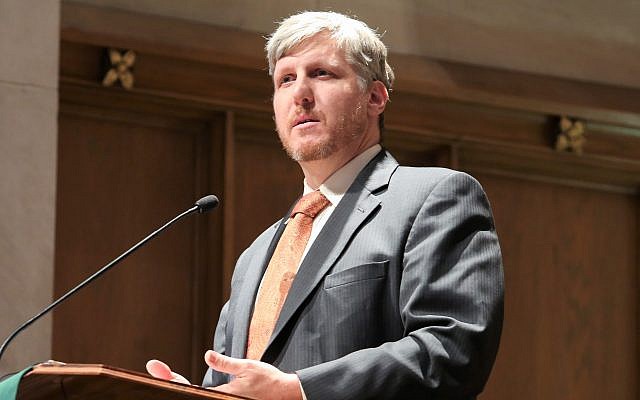Confrontation with True Slavery
This Passover holiday was met with more bloodshed, hate and evil than I can remember in my many years as a practitioner of my Jewish faith.
Rabbi Laurence Rosenthal serves Ahavath Achim Synagogue in Buckhead.

This Passover holiday was met with more bloodshed, hate and evil than I can remember in my many years as a practitioner of my Jewish faith. This year the plagues jumped off the page of my haggadah and onto my news feed.
On the second day of Passover, Easter Sunday for our Christian brothers and sisters, evil ripped through churches and hotels during holy worship. In the Sri Lankan cities of Colombo, Negombo and Batticaloa, a coordinated attack left 253 people dead and about 500 injured. Although a world away, both geographically and in some ways spiritually, it’s hard not to feel a connection to the people touched by such evil. As we all know too well, an attack in one place of worship is an attack on all places of worship. This is how Passover began.
By the end of holiday, my news feed was once again buzzing with new reports of hate, now a little closer to home. A synagogue in San Diego was met on our final day of Passover with hatred. During this spiritual time when our scriptures recall the closing of the waters upon our enemies and our people’s song at the Sea of Reeds, a gunman entered a Jewish sacred space and desecrated its song with the sounds of bullets and screams.
Even though the worship in both places might have looked different, the spiritual essence has major similarities. Each community was gathered together recalling a holy story from their people’s past in an attempt to commune with the infinite. What both communities encountered during their worship was the manifestation of true slavery. This is ironic since both communities (in conjunction with our own communities) were engaged in sacred efforts to rid ourselves of such bondage.
In the Sri Lankan community, our Christian neighbors were attempting to unshackle themselves from the bondage of sin through their sacred story of salvation. For our Jewish brothers and sisters in San Diego, they were offering praise to Hakadosh Baruch Hu, the Holy One of Blessing, for the redemption from Egyptian slavery and the ushering in of a new life filled with dignity and self-determination.
In both places, the perpetrators were playing out their own enslavement. Enslavement to an ideology that is devoid of God’s compassion and concern. … Enslavement to a twisted theology that would diminish God’s ever-present love and strength by thinking that thousands, if not millions of people, labeled as ‘the other’ are the embodiment of evil that must be destroyed. … Enslavement to a hate that sees fathers holding hands with daughters, mothers carrying their sleeping sons on their shoulders, lovers embracing each other as they walk, and seeing a need to obliterate these beautiful images. What a dark and fearful world these individuals live in. What enslavement these perpetrators experience in every waking moment.
It is interesting that our Passover experience prescribes that each of us must see ourselves as if we were slaves in Egypt and brought out from slavery to freedom. Yet, the haggadah spends a large portion of its pages describing the 10 plagues experienced by the Egyptians. The haggadah barely touches on the pain and suffering brought upon the Jewish people through the building of storage cities of Pithom and Ramesses. Instead, we talk a lot about blood and frogs and boils and cattle disease, all things that our perpetrators experienced, not us. In some ways, our haggadah is showing us that if we want to understand true slavery, we need to look at the Egyptians and see how they were enslaved to their own hate, fear and genocidal ambitions.
Although the haggadah is insistent that each generation must see itself as if WE were brought out of enslavement, we don’t need to imagine too hard to see what true slavery really looks like. Today, it’s not found with chains and shackles. Instead, we can see slavery in the suspicious eyes of those who view their neighbors as ‘the other.’
Slavery is a mindset that can see no other choice but to blow up churches and shoot up synagogues and mosques. Slavery is listening only to the paranoid, hate-filled rhetoric of a single source without any attempt to broaden one’s perspective and seek opportunities to learn about ‘the other’ through open-minded encounter.
What can we do? Is there hope? Yes, we will win this battle! Our sacred task is to bring light into a dark world. We cannot fulfill God’s will and commandments by lessening our light in the hope it will go unnoticed by those who might do us harm due to their enslavement to hate. Instead, we must shine brighter and bring in others to help generate radiance and warmth. Reach out and connect with the people you might consider different and separate from yourself.
If engaging and creating those spaces to encounter seems too daunting or fearful on your own, encourage your worship community to create that sacred space where you will feel safe and able to engage and encounter with an open heart and an extended hand.
Our Passover story teaches us that even amidst extraordinary hate and genocidal madness, we can overcome. We can win. But to do it, we must walk into that turbulent Sea of Reeds together.
Rabbi Laurence Rosenthal is a rabbi at Ahavath Achim Synagogue.



comments